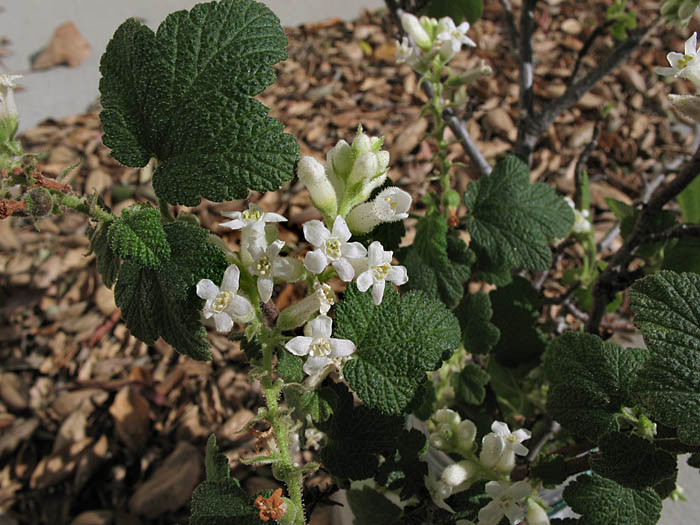
Also called white chaparral currant, this deciduous shrub is native to Baha California and coastal areas of California. It is a member of the currant family, Grossulariaceae, that consists of one genus with about 200 species that are currants or gooseberries. The plant grows up to 10′ tall and has a fuzzy, glandular stem with dark brown bark that shreds with maturity. The hairy, medium green leaves are .4-1.6″ long, palmately divided in to 3-5 toothed lobes, and are very aromatic. From late autumn to early spring, short pendulous loose racemes of 10-25 flowers appear. Each flower is tubular with white or pink-tinged sepals surrounding whitish petals. Although the flowers are not showy they are very fragrant and attract hummingbirds and other pollinators. The hairy, sticky, .4″ wide fruit may be orange, purple, pink or red, and provides food for birds and small mammals. White flowering currant is valued for its fragrant fruits, winter bloom time, and tolerance of drought and heat but may drop its leaves when the temperatures are high. The genus name, Ribes, comes from the Arabic or Persian word ribas meaning acid. The specific epithet, indecorum, is the Latin word meaning unsightly.
Type: Deciduous shrub
Outstanding Feature: Flowers’ scent and bloom time
Form: Columnar
Growth Rate: Moderate
Bloom: Loose racemes of 10-25 tubular flowers with white or pink-tinged sepals surrounding whitish petals from late autumn to early spring
Size: 5-10′ H x 1-2′ W
Light: Full sun to partial shade
Soil: Sandy, dry to medium moist, well-drained
Hardiness: Zones 5-10
Care: Low maintenance
Pests and Diseases: None of significance
Propagation: Seed
Outstanding Selections: None available
Photo Credit: NPS Wikimedia Commons